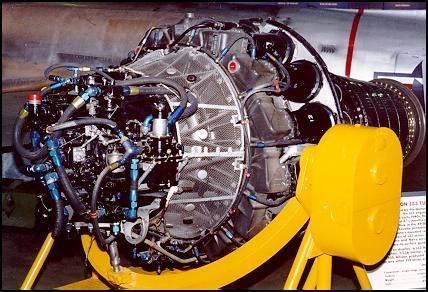 | ||
The General Electric/Allison J33 was a development of the General Electric J31, enlarged to produce significantly greater thrust, starting at 4,000 lbf (18 kN) and ending at 4,600 lbf (20 kN) with an additional low-altitude boost to 5,400 lbf (24 kN) with water-alcohol injection.
Contents
Development
The J33 was originally developed by General Electric as a follow-on to their work with the designs of Frank Whittle during World War II. Their first engine was known as the General Electric I-A, but after major changes to adapt it to US production and to increase thrust, it started limited production as the I-16 in 1942, the 16 referring to its 1,600 lbf (7.1 kN) thrust. Full production started as the J31 when the United States Army Air Forces introduced common naming for all their engine projects.
Along with the I-16, GE also started work on an enlarged version, known as the I-40. As the name implied, the engine was designed to provide 4,000 lbf (18 kN). Apart from size, the main difference between I-16 and the I-40 was the combustion system: the I-16 had ten reverse-flow cans, whereas the I-40 had 14 straight-through combustors. The development cycle was remarkably rapid. Design work started in mid-1943 and the first prototype underwent static testing on January 13, 1944.
Lockheed was in the midst of the XP-80 project at the time, originally intending to power their design with a US-produced version of the Halford H-1 of about 3,000 lbf (13 kN). Production of the H-1 ran into delays, and since the I-40 would dramatically improve performance, plans were made to fit the prototypes with the I-40 instead.
The I-40 became important to the USAAF's plans when the I-16 powered P-59 was skipped over in favor of the I-40 powered P-80 as the US's first production jet fighter. In 1945 the license to actually produce the engine was not given to General Electric, but Allison instead. Allison, working largely from government-owned wartime factories, could produce the engine in quantity more quickly and cheaply.
By the time the production lines were shut down Allison had built over 6,600 J33's, and General Electric another 300 (mostly the early runs).
In 1958, surplus J33s were used in jet donkeys pushing dead loads at 200 knots to test aircraft carrier arresting gear cables and tailhooks at Lakehurst.
A model of the J33 intended for civil use, designated the Allison 400-C4, in 1948 became the first US gas turbine certificated for commercial transport use.
Variants
Applications
Specifications (Allison J33-A-35)
Data from
